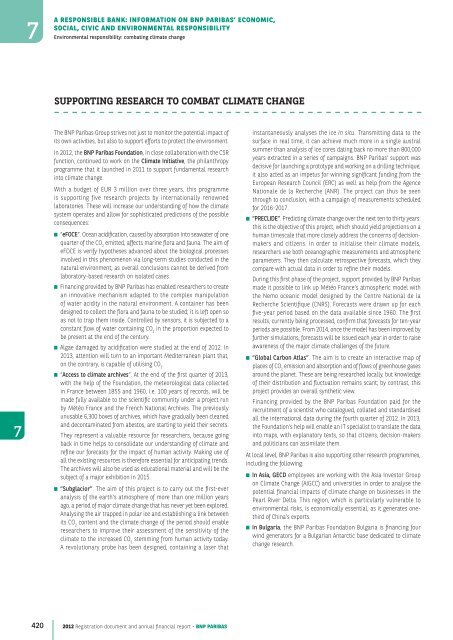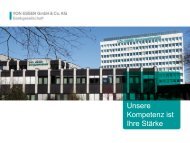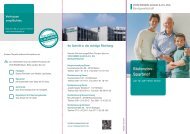2012 Registration document and annual financial report - BNP Paribas
2012 Registration document and annual financial report - BNP Paribas
2012 Registration document and annual financial report - BNP Paribas
- No tags were found...
Create successful ePaper yourself
Turn your PDF publications into a flip-book with our unique Google optimized e-Paper software.
7ARESPONSIBLE BANK: INFORMATION ON <strong>BNP</strong> PARIBAS’ ECONOMIC,SOCIAL, CIVIC AND ENVIRONMENTAL RESPONSIBILITYEnvironmental responsibility: combating climate changeSUPPORTING RESEARCH TO COMBAT CLIMATE CHANGE7The <strong>BNP</strong> <strong>Paribas</strong> Group strives not just to monitor the potential impact ofits own activities, but also to support efforts to protect the environment.In <strong>2012</strong>, the <strong>BNP</strong> <strong>Paribas</strong> Foundation, in close collaboration with the CSRfunction, continued to work on the Climate Initiative, the philanthropyprogramme that it launched in 2011 to support fundamental researchinto climate change.With a budget of EUR 3 million over three years, this programmeis supporting five research projects by internationally renownedlaboratories. These will increase our underst<strong>and</strong>ing of how the climatesystem operates <strong>and</strong> allow for sophisticated predictions of the possibleconsequences:■ “eFOCE”. Ocean acidification, caused by absorption into seawater of onequarter of the CO 2emitted, affects marine flora <strong>and</strong> fauna. The aim ofeFOCE is verify hypotheses advanced about the biological processesinvolved in this phenomenon via long-term studies conducted in thenatural environment; as overall conclusions cannot be derived fromlaboratory-based research on isolated cases.■ Financing provided by <strong>BNP</strong> <strong>Paribas</strong> has enabled researchers to createan innovative mechanism adapted to the complex manipulationof water acidity in the natural environment. A container has beendesigned to collect the flora <strong>and</strong> fauna to be studied; it is left open soas not to trap them inside. Controlled by sensors, it is subjected to aconstant flow of water containing CO 2in the proportion expected tobe present at the end of the century.■ Algae damaged by acidification were studied at the end of <strong>2012</strong>. In2013, attention will turn to an important Mediterranean plant that,on the contrary, is capable of utilising CO 2.■ “Access to climate archives”. At the end of the first quarter of 2013,with the help of the Foundation, the meteorological data collectedin France between 1855 <strong>and</strong> 1960, i.e. 100 years of records, will bemade fully available to the scientific community under a project runby Météo France <strong>and</strong> the French National Archives. The previouslyunusable 6,300 boxes of archives, which have gradually been cleaned<strong>and</strong> decontaminated from abestos, are starting to yield their secrets.They represent a valuable resource for researchers, because goingback in time helps to consolidate our underst<strong>and</strong>ing of climate <strong>and</strong>refine our forecasts for the impact of human activity. Making use ofall the existing resources is therefore essential for anticipating trends.The archives will also be used as educational material <strong>and</strong> will be thesubject of a major exhibition in 2015.■ “Subglacior”. The aim of this project is to carry out the first-everanalysis of the earth’s atmosphere of more than one million yearsago, a period of major climate change that has never yet been explored.Analysing the air trapped in polar ice <strong>and</strong> establishing a link betweenits CO 2content <strong>and</strong> the climate change of the period should enableresearchers to improve their assessment of the sensitivity of theclimate to the increased CO 2stemming from human activity today.A revolutionary probe has been designed, containing a laser thatinstantaneously analyses the ice in situ. Transmitting data to thesurface in real time, it can achieve much more in a single australsummer than analysis of ice cores dating back no more than 800,000years extracted in a series of campaigns. <strong>BNP</strong> <strong>Paribas</strong>’ support wasdecisive for launching a prototype <strong>and</strong> working on a drilling technique;it also acted as an impetus for winning significant funding from theEuropean Research Council (ERC) as well as help from the AgenceNationale de la Recherche (ANR). The project can thus be seenthrough to conclusion, with a campaign of measurements scheduledfor 2016-2017.■ “PRECLIDE”. Predicting climate change over the next ten to thirty years:this is the objective of this project, which should yield projections on ahuman timescale that more closely address the concerns of decisionmakers<strong>and</strong> citizens. In order to initialise their climate models,researchers use both oceanographic measurements <strong>and</strong> atmosphericparameters. They then calculate retrospective forecasts, which theycompare with actual data in order to refine their models.During this first phase of the project, support provided by <strong>BNP</strong> <strong>Paribas</strong>made it possible to link up Météo France’s atmospheric model withthe Nemo oceanic model designed by the Centre National de laRecherche Scientifique (CNRS). Forecasts were drawn up for eachfive-year period based on the data available since 1960. The firstresults, currently being processed, confirm that forecasts for ten-yearperiods are possible. From 2014, once the model has been improved byfurther simulations, forecasts will be issued each year in order to raiseawareness of the major climate challenges of the future.■ “Global Carbon Atlas”. The aim is to create an interactive map ofplaces of CO 2emission <strong>and</strong> absorption <strong>and</strong> of flows of greenhouse gasesaround the planet. These are being researched locally, but knowledgeof their distribution <strong>and</strong> fluctuation remains scant; by contrast, thisproject provides an overall synthetic view.Financing provided by the <strong>BNP</strong> <strong>Paribas</strong> Foundation paid for therecruitment of a scientist who catalogued, collated <strong>and</strong> st<strong>and</strong>ardisedall the international data during the fourth quarter of <strong>2012</strong>. In 2013,the Foundation’s help will enable an IT specialist to translate the datainto maps, with explanatory texts, so that citizens, decision-makers<strong>and</strong> politicians can assimilate them.At local level, <strong>BNP</strong> <strong>Paribas</strong> is also supporting other research programmes,including the following:■ In Asia, GECD employees are working with the Asia Investor Groupon Climate Change (AIGCC) <strong>and</strong> universities in order to analyse thepotential <strong>financial</strong> impacts of climate change on businesses in thePearl River Delta. This region, which is particularly vulnerable toenvironmental risks, is economically essential, as it generates onethirdof China’s exports.■ In Bulgaria, the <strong>BNP</strong> <strong>Paribas</strong> Foundation Bulgaria is financing fourwind generators for a Bulgarian Antarctic base dedicated to climatechange research.420<strong>2012</strong> <strong>Registration</strong> <strong>document</strong> <strong>and</strong> <strong>annual</strong> <strong>financial</strong> <strong>report</strong> - <strong>BNP</strong> PARIBAS





